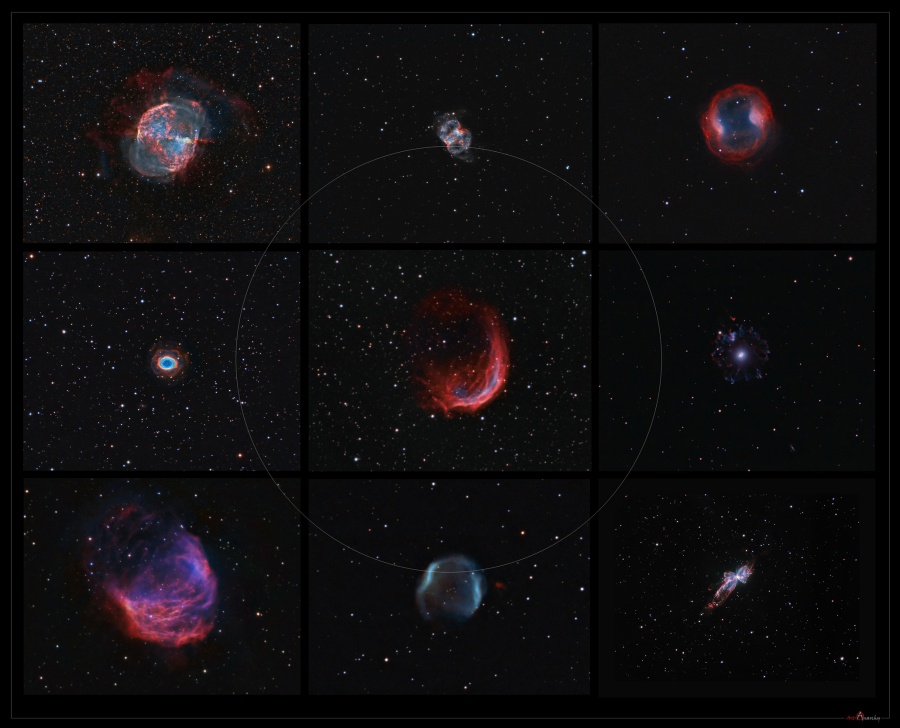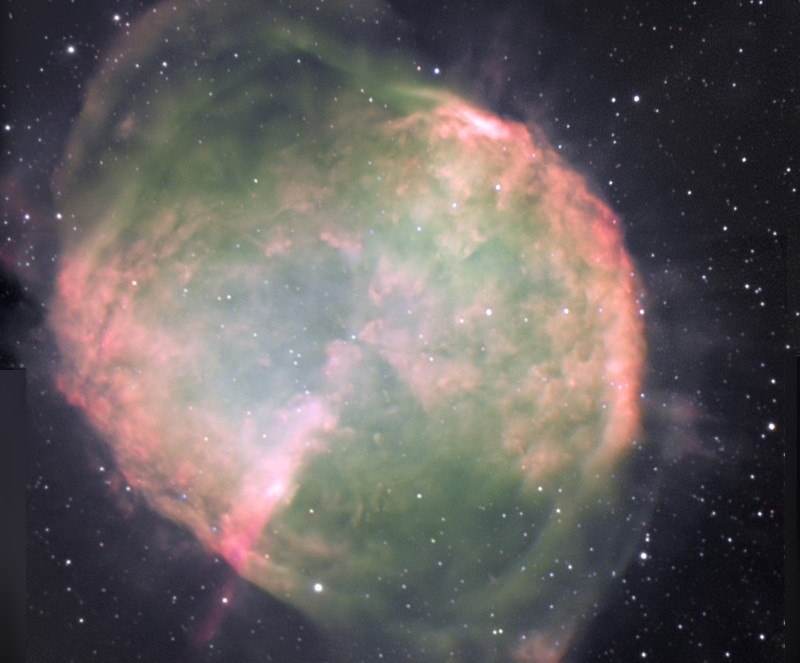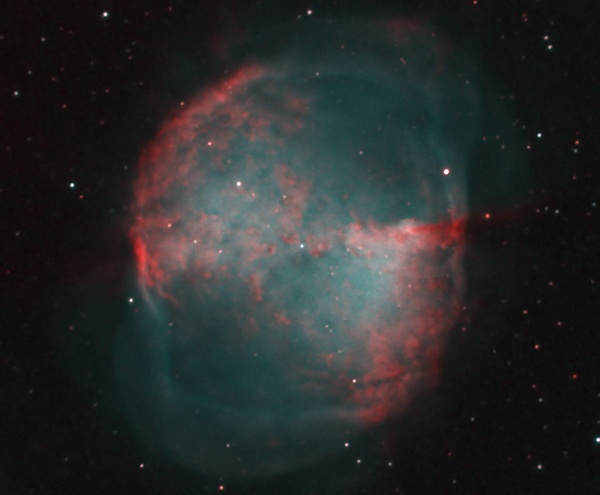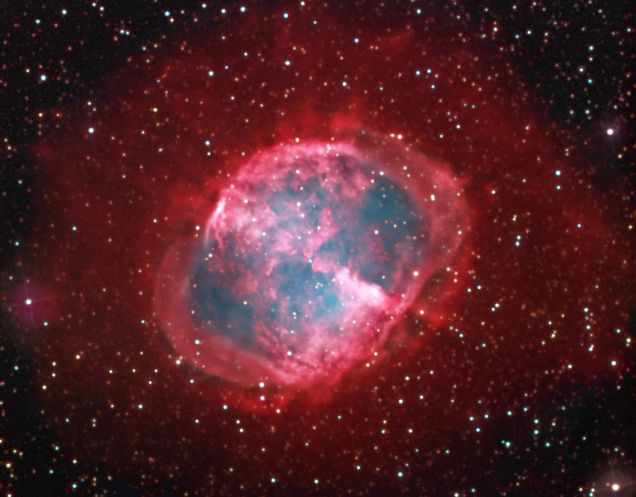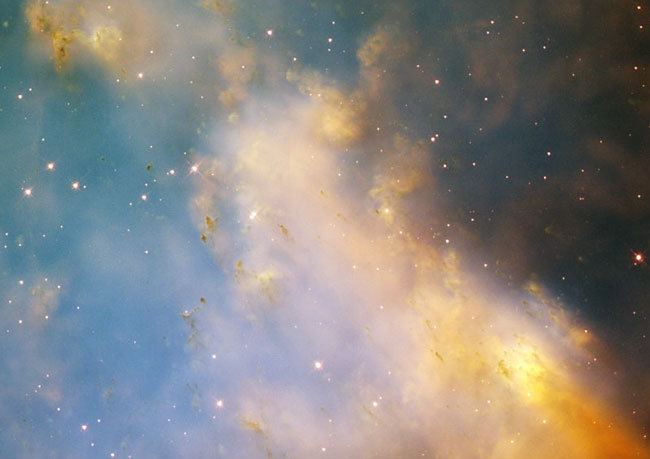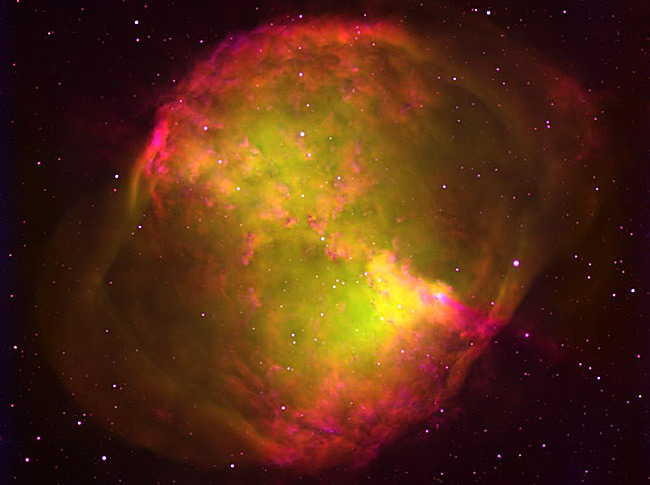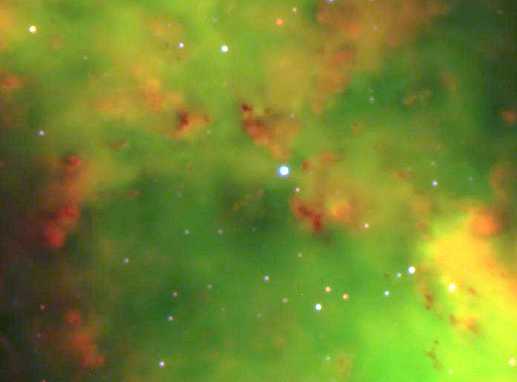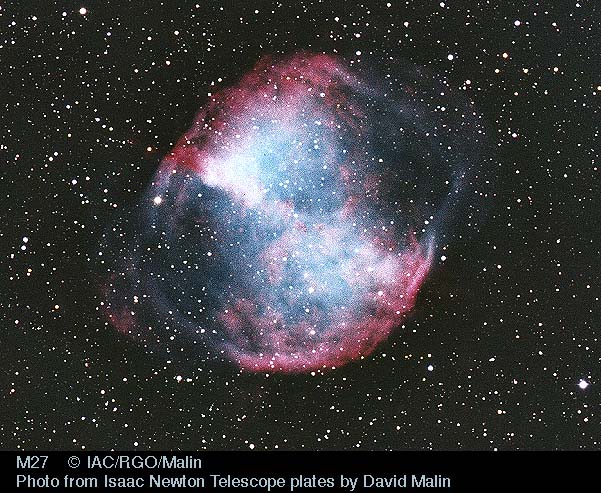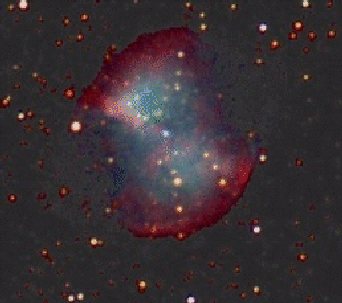APOD Collection: Messier 27, the Dumbbell Nebula
APOD Collection: Messier 27, the Dumbbell Nebula
Messier 27: The Dumbbell Nebula
All titles are clickable and link to the original APOD page; click on an image for a larger view of it.
2011 February 18 Cast off by dying sunlike stars, planetary nebulae are a brief but glorious final phase of stellar evolution. The gaseous shrouds are ionized by an extremely hot central source, the shrinking core of a star running out of fuel for nuclear fusion. Shining in the cosmic night, their simple symmetries are fascinating and have inspired this planetary nebula poster project. In it, nine planetaries are displayed for comparison in a 3x3 grid. Of course, planetary nebula fans should be able to pick out the bright Messier objects M27 - the Dumbbell Nebula, M76 - the Little Dumbbell, and M57 - the Ring Nebula, as well as NGC 6543, aka the Cat's Eye Nebula. Lesser known nebulae include the Medusa and the Bug. All the images were made with detailed narrow band data and are shown at the same angular scale, spanning 20 arc minutes (1/3 degree). At that scale, the grey circle represents the apparent size of the Full Moon. These planetary nebulae hint at the fate of our own Sun as its core runs out of nuclear fuel in another 5 billion years.
2010 August 26 While hunting for comets in the skies above 18th century France, astronomer Charles Messier diligently kept a list of the things he encountered that were definitely not comets. This is number 27 on his now famous not-a-comet list. In fact, 21st century astronomers would identify it as a planetary nebula, but it's not a planet either, even though it may appear round and planet-like in a small telescope. Messier 27 (M27) is an excellent example of a gaseous emission nebula created as a sun-like star runs out of nuclear fuel in its core. The nebula forms as the star's outer layers are expelled into space, with a visible glow generated by atoms excited by the dying star's intense but invisible ultraviolet light. Known by the popular name of the Dumbbell Nebula, the beautifully symmetric interstellar gas cloud is over 2.5 light-years across and about 1,200 light-years away in the constellation Vulpecula. This impressive color composite highlights details within the well-studied central region and fainter, seldom imaged features in the nebula's outer halo. It includes narrowband images recorded using filters sensitive to emission from oxygen atoms, shown in blue-green hues, and hydrogen atoms in red.
2008 December 17 These two nebulae are cataloged as M27 (left) and M76, popularly known as The Dumbbell and the Little Dumbbell. Not intended to indicate substandard mental prowess, their popular names refer to their similar, dumbbell or hourglass shapes. Both are planetary nebulae, gaseous shrouds cast off by dying sunlike stars, and are similar in physical size, at a light-year or so across. In each panel, the images were made at the same scale, so the apparent size difference is mostly because one is closer. Distance estimates suggest 1,200 light-years for the Dumbbell compared to 3,000 light-years or more for the Little Dumbell. These deep, narrow-band, false-color images show some remarkably complex structures in M27 and M76, highlighting emission from hydrogen, nitrogen, and oxygen atoms within the cosmic clouds.
2008 June 26 Born on June 26th in 1730, astronomer Charles Messier scanned 18th century French skies for comets. To avoid confusion and aid his comet hunting, he diligently recorded this object as number 27 on his list of things which are definitely not comets. In fact, 21st century astronomers would classify it as a Planetary Nebula, but it's not a planet either, even though it may appear round and planet-like in a small telescope. Messier 27 (M27) is now known to be an excellent example of a gaseous emission nebula created as a sun-like star runs out of nuclear fuel in its core. The nebula forms as the star's outer layers are expelled into space, with a visible glow generated by atoms excited by the dying star's intense but invisible ultraviolet light. Known by the popular name of the Dumbbell Nebula, the beautifully symmetric interstellar gas cloud is over 2.5 light-years across and about 1,200 light-years away in the constellation Vulpecula. This impressive color composite highlights subtle jet features in the nebula. It was recorded with a robotic telescope sited in Hawaii using narrow band filters sensitive to emission from oxygen atoms (shown in green) and hydrogen atoms. The hydrogen emission is seen as red (H-alpha) and fainter bluish hues (H-beta).
2006 August 3 While searching the skies above 18th century France for comets, astronomer Charles Messier diligently recorded this object as number 27 on his list of things which are definitely not comets. So what is it? Well, 20th century astronomers would classify it as a Planetary Nebula ... but it's not a planet either, even though it may appear round and planet-like in a small telescope. Messier 27 (M27) is now known to be an excellent example of a gaseous emission nebula created as a sun-like star runs out of nuclear fuel in its core. The nebula forms as the star's outer layers are expelled into space, with a visible glow generated by atoms excited by the dying star's intense but invisible ultraviolet light. Known by the popular name of the Dumbbell Nebula, the beautifully symmetric interstellar gas cloud is about 1,200 light-years away in the constellation Vulpecula. This intriguing color composite view was recorded through narrow band filters sensitive to emission from hydrogen atoms (shown in red) and oxygen atoms (shown in blue/green).
2005 June 3 The first hint of what will become of our Sun was discovered inadvertently in 1764. At that time, Charles Messier was compiling a list of diffuse objects not to be confused with comets. The 27th object on Messier's list, now known as M27 or the Dumbbell Nebula, is a planetary nebula, the type of nebula our Sun will produce when nuclear fusion stops in its core. M27 is one of the brightest planetary nebulae on the sky, and can be seen in the constellation Vulpecula with binoculars. It takes light about 1000 years to reach us from M27, shown above, digitally sharpened, in three standard colors. Understanding the physics and significance of M27 was well beyond 18th century science. Even today, many things remain mysterious about bipolar planetary nebula like M27, including the physical mechanism that expels a low-mass star's gaseous outer-envelope, leaving an X-ray hot white dwarf.
2004 April 24
2002 March 2
October 23, 1999 While searching the skies above 18th century France for comets, astronomer Charles Messier diligently recorded this object as number 27 on his list of things which are definitely not comets. So what is it? Well, 21st century astronomers would classify it as a Planetary Nebula ... but it's not a planet either, even though it may appear round and planet-like in a small telescope. Messier 27 (M27) is now known to be an excellent example of a gaseous emission nebula created as a sun-like star runs out of nuclear fuel in its core. The nebula forms as the star's outer layers are expelled into space. The visible glow is generated as atoms are excited by the dying star's intense but invisible ultraviolet light. Known by the popular name Dumbbell Nebula, the beautifully symmetric interstellar gas cloud is about 1,200 light-years away in the constellation Vulpecula. This gorgeous synthetic color picture of M27 was produced during testing of one of the European Southern Observatory's Very Large Telescopes.
2003 July 25 In 1764, French astronomer Charles Messier sighted this gorgeous cosmic cloud which he described as an oval nebula without stars. Cataloged as M27, it is now popularly known as the Dumbbell Nebula, not for its substandard academic performance but for the elongated shape, like a bar with weights on each end, which first caught Messier's eye. This deep image of the bright planetary nebula does reveal the Dumbell's central star though, and an array of foreground and background stars toward the sly constellation Vulpecula. The picture is a composite that includes 8 hours of exposure through a filter designed to record only the light of hydrogen atoms, tracing the intricate details of the nebula's faint outer halo which spans light-years. Thought to be an example of the fate awaiting our own Sun 5 billion years hence, the Dumbbell Nebula is about 1,200 light-years away.
2003 February 11 What causes unusual knots of gas and dust in planetary nebulas? Seen previously in the Ring Nebula, the Helix Nebula, and the Eskimo Nebula, the knots' existence was not predicted previously and still not well understood. Pictured above is a newly released image of the Dumbbell Nebula by the Hubble Space Telescope showing details of its gaseous knots. Also visible are many bright young stars and dark sheets of interstellar dust. The Dumbbell Nebula, also known as M27, is a planetary nebula thought similar to what our Sun will become when it runs out of core fuel for nuclear fusion. Recent study of similar cometary knots indicates that they include concentrations of relatively cold molecular gas and that they change significantly as the planetary nebula ages.
2003 January 13 The first hint of what will become of our Sun was discovered inadvertently in 1764. At that time, Charles Messier was compiling a list of "annoying" diffuse objects not to be confused with "interesting" comets. The 27th object on Messier's list, now known as M27 or the Dumbbell Nebula, is a planetary nebula, the type of nebula our Sun will produce when nuclear fusion stops in its core. M27 is one of the brightest planetary nebulae on the sky, and can be seen in the constellation Vulpecula with binoculars. It takes light about 1000 years to reach us from M27, shown above, digitally sharpened, in three isolated colors emitted by hydrogen and oxygen. Understanding the physics and significance of M27 was well beyond 18th century science. Even today, many things remain mysterious about bipolar planetary nebula like M27, including the physical mechanism that expels a low-mass star's gaseous outer-envelope, leaving an X-ray hot white dwarf.
2001 March 6 The first hint of what will become of our Sun was discovered inadvertently in 1764. At that time, Charles Messier was compiling a list of "annoying" diffuse objects not to be confused with "interesting" comets. The 27th object on Messier's list, now known as M27 or the Dumbbell Nebula, is a planetary nebula, the type of nebula our Sun will produce when nuclear fusion stops in its core. M27 is one of the brightest planetary nebulae on the sky, and can be seen in the constellation Vulpecula with binoculars. It takes light about 1000 years to reach us from M27, shown above in representative colors. Understanding the physics and significance of M27 was well beyond 18th century science. Even today, many things remain mysterious about bipolar planetary nebula like M27, including the physical mechanism that expels a low-mass star's gaseous outer-envelope, leaving an X-ray hot white dwarf.
October 13, 1998 Here's part of the Dumbbell Nebula that you can't see through binoculars. To see this, we suggest a sophisticated spectrograph attached to a telescope with an 8-meter aperture. Pictured above is the central part of the Dumbbell Nebula, also known as M27 and NGC 6853. The Dumbbell is a planetary nebula created by the aging bright star visible just right of center. The nebula, located in the constellation Vulpecula, is thousands of years old. Visible in this false-color photograph is glowing hydrogen gas (green) and enigmatical globules of dense molecular gas and dust (red).
October 9, 1998 While searching the skies above 18th century France for comets, astronomer Charles Messier diligently recorded this object as number 27 on his list of things which are definitely not comets. So what is it? Well, 20th century astronomers would classify it as a Planetary Nebula ... but it's not a planet either, even though it may appear round and planet-like in a small telescope. Messier 27 (M27) is now known to be an excellent example of a gaseous emission nebula created as a sun-like star runs out of nuclear fuel in its core. The nebula forms as the star's outer layers are expelled into space, with a visible glow generated by atoms excited by the dying star's intense but invisible ultraviolet light. Known by the popular name of the "Dumbbell Nebula", the beautifully symmetric interstellar gas cloud is about 1,200 light-years away in the constellation Vulpecula. This gorgeous synthetic color picture of M27 was produced during testing of the European Southern Observatory's new Very Large Telescope.
February 18, 1998 The first hint of what will become of our Sun was discovered inadvertently in 1764. At that time, Charles Messier was compiling a list of "annoying" diffuse objects not to be confused with "interesting" comets. The 27th object on Messier's list, now known as M27 or the Dumbbell Nebula, is a planetary nebula, the type of nebula our Sun will produce when nuclear fusion stops in its core. M27 is one of the brightest planetary nebulae on the sky, and can be seen in the constellation Vulpecula with binoculars. It takes light about 1000 years to reach us from M27. Understanding the physics and significance of M27 was well beyond 18th century science. Even today, many things remain mysterious about bipolar planetary nebula like M27, including the physical mechanism that expels a low-mass star's gaseous outer-envelope, leaving an X-ray hot white dwarf.
July 29, 1995 The Dumbbell Nebula is a beautiful red and blue planetary nebula in the constellation of Vulpecula. It is the 27th object on Charles Messier's list of diffuse sky objects, and so is referred to as M27. Its high surface brightness makes it a good target for small telescopes. The term planetary nebula, used to describe this general class of objects, is misleading. Although these objects may appear round and planet-like in small telescopes, astronomers have determined them to be stars surrounded by cocoons of gas blown off in the late stages of evolution.
For more information on M27 see The Electronic Universe Project's write-up.
Many images of Messier objects can be found in The Electronic Universe Project's The Galaxy Gallery: Messier Objects.
A closed mouth gathers no foot.
